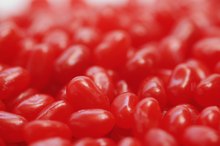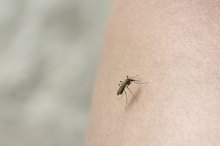Can You Be Allergic to Red Food?
You can be allergic to essentially any food, either natural or processed, if your body perceives it to be a problem. Sometimes the body is right because the compound in the food is toxic in some capacity, but sometimes it’s wrong and overreacts to a compound that’s normally innocuous. Naturally red foods are not a common cause of food allergies in most people. Artificially colored red foods may cause allergic reactions, especially in children, although there is no scientific evidence to support this. Consult with your doctor if you or your children experience food allergies.
If you are experiencing serious medical symptoms, seek emergency treatment immediately.
Allergic Reactions
People can be allergic to virtually anything as long as their bodies perceive it to be undesirable or foreign. Most allergy symptoms are due to an increase in histamine levels within tissues, which is essentially an overreaction by the immune system in an attempt to control and fight the triggering compound. Histamine causes blood vessels to dilate, which increases blood flow and results in swelling. The triggering compounds are often dust or pollen from flowering plants, but many proteins and chemicals in food can also trigger an allergic reaction. According to “Harrison's Principles of Internal Medicine,” common symptoms include nasal congestion; swelling in the mouth and throat and around the face; difficulty breathing and swallowing; skin rashes; gastrointestinal problems; headaches; and dizziness 1. Severe allergic reactions can result in shock, seizures, coma and death.
- People can be allergic to virtually anything as long as their bodies perceive it to be undesirable or foreign.
- Most allergy symptoms are due to an increase in histamine levels within tissues, which is essentially an overreaction by the immune system in an attempt to control and fight the triggering compound.
Red Food Allergies
Signs & Symptoms of an Allergy to Red Dye
Learn More
Allergies to foods that are naturally red in color are relatively rare. None of these foods are considered red, although a few red fruits are known to trigger relatively mild allergic reactions in some sensitive individuals. Strawberries, apples, plums and tomatoes are the most common culprits, although they typically lead to oral allergy syndrome, which is the development of an itchy rash or contact dermatitis wherever there is contact with the food, such as:
- the lips
- tongue
- throat
The allergens in strawberries and tomatoes are thought to be certain proteins, which are destroyed by heat.
Red Food Dye
The most common red food dye is called red dye number 40, which is more prevalent in foods, treats and beverages that are marketed toward children. It’s been banned from use in children’s products in some countries, but the U.S. Food and Drug Administration insists that it’s safe for all ages, according to the “Compendium of Pharmaceuticals and Specialties."
Recommendations
Signs & Symptoms of an Allergy to Red Dye
Learn More
Avoiding an allergy-causing food completely is the only way to prevent allergic reactions. Consequently, it is always a good idea to read labels carefully. If you are mildly allergic to red fruits or vegetables, try cooking the food before you eat it, as heat destroys protein-based allergens. If you are severely allergic, talk to your doctor before you do any experimenting.
- Avoiding an allergy-causing food completely is the only way to prevent allergic reactions.
- If you are mildly allergic to red fruits or vegetables, try cooking the food before you eat it, as heat destroys protein-based allergens.
Related Articles
References
- Harrison's Principles of Internal Medicine; A. Fauci et al.
- Public Health Nutrition: From Principles to Practice; Mark Lawrence and Tony Worsley
- Compendium of Pharmaceuticals and Specialties; Canadian Pharmacists Association
- Food Allergy Research and Education (FARE). Facts and Statistics.
- Zukiewicz-sobczak WA, Wróblewska P, Adamczuk P, Kopczyński P. Causes, symptoms and prevention of food allergy. Postepy Dermatol Alergol. 2013;30(2):113-6. doi:10.5114/pdia.2013.34162
- Tupper J, Visser S. Anaphylaxis: A review and update. Can Fam Physician. 2010;56(10):1009-11.
- American College of Allergy, Asthma and Immunology. Food Allergy Diagnosis. Updated February 12, 2019.
- American Academy of Allergy, Asthma & Immunology. Food Allergy: A Practice Parameter Update. 2014. doi:10.1016/j.jaci.2014.05.013
- Boyce JA, Assa’ad A, Burks AW, et al. NIAID-Sponsored Expert Panel. Guidelines for the Diagnosis and Management of Food Allergy in the United States: Report of the NIAID-Sponsored Expert Panel. The Journal of Allergy and Clinical Immunology, 2010. doi:10.1016/j.jaci.2010.10.007
- Branum AM, Lukacs SL. Food Allergy Among U.S. Children: Trends in Prevalence and Hospitalizations. NCHS Data Brief, Centers for Disease Control (CDC), 2008.
- Food Allergy Research and Education (FARE). Facts and Statistics.
- Liu AH, Jaramillo R, Sicherer SH, et al. National Prevalence and Risk Factors for Food Allergy and Relationship to Asthma: Results from the National Health and Nutrition Examination Survey. Journal of Allergy and Clinical Immunology, 2010. doi:10.1016/j.jaci.2010.07.026
- Sicherer, SH. Food Allergies: A Complete Guide for Eating When Your Life Depends on It. Baltimore, MD: The Johns Hopkins University Press (2013).
Writer Bio
Sirah Dubois is currently a PhD student in food science after having completed her master's degree in nutrition at the University of Alberta. She has worked in private practice as a dietitian in Edmonton, Canada and her nutrition-related articles have appeared in The Edmonton Journal newspaper.








